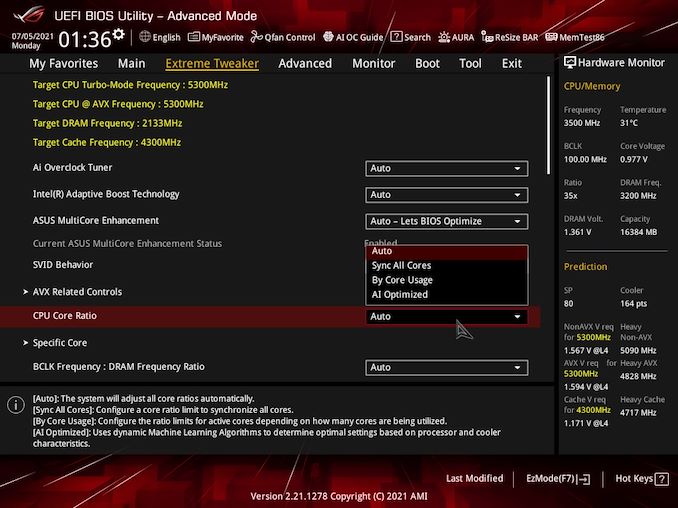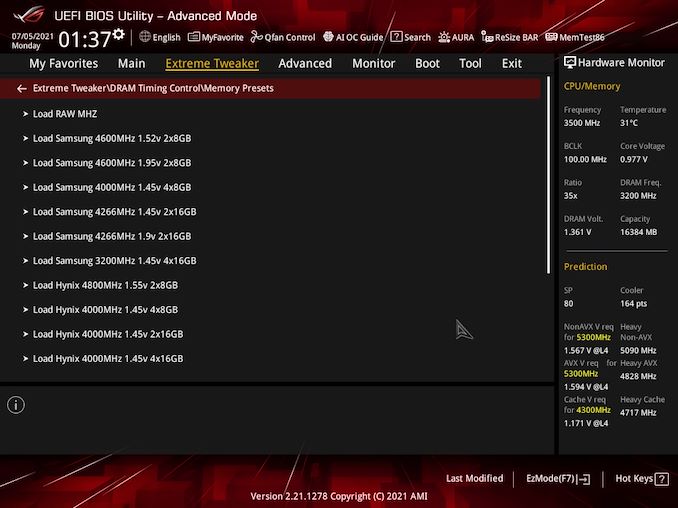ASUS ROG Maximus XIII Hero Review: Everything for Rocket Lake
by Gavin Bonshor on July 9, 2021 9:00 AM ESTOverclocking
Experience with the ASUS ROG Maximus XIII Hero
The art of overclocking can be considered as a skill, as to get the right combination of settings to deliver an optimized, yet stable enough system to deliver the performance can be time-consuming and tedious. Despite the excellent work from both Intel and AMD over the last couple of years with interpretations of 'turbo' and 'boost', this doesn't typically affect all of the cores, and instead focuses on one or two. On an eight-core processor such as the Intel Core i9-11900K, providing whatever software of application is being used can utilize the cores and threads, typically more performance can be had from pushing all of the cores higher. At present, Intel employs some of the most aggressive methods of automatic overclocking with its Thermal Velocity Boost (TVB), and more recently with Rocket Lake, its new Adaptive Boost Technology (ABT) on its 11th Gen Core i9 K and KF processors.
Perhaps the biggest disadvantage when it comes to overclocking the processor is having to deal with the extra heat and power implications. As Intel is pushing its silicon almost to its limit right out of the factory, adequate cooling is needed. Due to previous experiences when overclocking our i9-11900K in previous Z590 reviews, we've seen power consumption figures surpassing 350 W when overclocking, which is a phenomenal amount of wattage for an eight-core chip. Even at default settings, new processors, from both Intel and AMD, typically run warmer than previous generations, so we recommend using premium cooling solutions such as AIO CPU coolers, or even large tower coolers to help manage the extra heat generated.
Focusing on our experience while overclocking on the Hero, all of the board's relevant settings are located within the Extreme Tweaker menu within the Advanced mode of the firmware. ASUS includes extensive options for overclocking both the CPU and memory and also includes relative options for users looking to overclock Intel's UHD integrated graphics.
For the CPU-specific options, users can overclock the cores in sync, or individually, with AVX offsetting for heavier workloads and improved stability. Users can even overclock on specific cores for users that already know what each individual core is capable of, with options for overclocking the cache, and plenty of voltage and power options to go along with it; more than most users will ever need to worry about. For extreme overclockers, there's plenty of options available in the voltage settings, with PLL, CPU VCore/Cache, VRM loadline calibration (LLC), and Intel's Thermal Velocity Boost (TVB) settings. Users can also let the firmware judge the best overclock via ASUS's AI (assisted intelligence) automatic overclocking, which users a lookup table within the firmware based on the efficacy of the cooling used.
Looking at memory overclocking on the ROG Maximus XIII Hero, ASUS includes tonnes of options for users to overclock the memory via frequency, enable or disable compatible X.M.P 2.0 profiles, as well as lots of primary, secondary, and tertiary memory latencies. ASUS does include a list of memory overclocking presets, from raw MHz to the fine-tuned Samsung and Hynix IC-specific profiles. The likely users of these profiles are extreme overclockers and benchmarkers, and it's unlikely that the regular user will be able to get their memory to run at these settings.
Overall, ASUS's ROG firmware contains more than enough settings for overclockers and enthusiasts to sink their teeth into. For the casual overclocker looking to squeeze out extra performance, users can simply adjust the CPU Core ratio to the desired frequency and adjust the CPU VCore (using override or adaptive voltage) for the easiest and best results.
Overclocking Methodology
Our standard overclocking methodology is as follows. We select the automatic overclock options and test for stability with POV-Ray and Prime95 to simulate high-end workloads. These stability tests aim to catch any immediate causes for memory or CPU errors.
For manual overclocks, based on the information gathered from the previous testing, start off at a nominal voltage and CPU multiplier, and the multiplier is increased until the stability tests are failed. The CPU voltage is increased gradually until the stability tests are passed. The process is repeated until the motherboard reduces the multiplier automatically (due to safety protocol) or the CPU temperature reaches a stupidly high level (105ºC+). Our testbed is not in a case, which should push overclocks higher with fresher (cooler) air.
Overclocking Results
Overclocking on our Intel Core i9-11900K with the ASUS ROG Maximus XIII Hero proved fruitful, and we experienced positive results across the board. Starting with default settings compared to ASUS's AI Optimization profile, we saw a nice jump in POV-Ray benchmark performance with CPU core temperatures of just 8 ºC higher, with power also not too out of whack.
Testing our manual overclocks from 4.7 GHz to 5.3 GHz also yielded positive results. We saw incremental POV-Ray performance increases from 4.7 GHz to 5.2 GHz, with temperatures at 5.3 GHz engaging Intel's thermal throttling which gave us a negative result. In terms of CPU Vcore to CPU VCore at full load variation, the Hero has very tight and consistent VDroop control throughout, even with the default loadline calibration profile. The board tended to slightly under volt up until we tested at 5.3 GHz at 1.45 V, which we then saw the board slightly overvolted, but all this is within a very small margin which was fantastic.
The ASUS ROG Maximus XIII Hero is a solid board for overclocking, with no issues, and we have no negative feedback to report. We believe users with binned Rocket Lake processors will get the most out of the silicon on ambient cooling methods, as well as be able to push overclocks in extreme settings with this board.













28 Comments
View All Comments
A5 - Friday, July 9, 2021 - link
$500 isn't mid-range by any stretch of the imagination, except in the wildest dreams of ASUS' CFO.shabby - Friday, July 9, 2021 - link
Lol indeed, wake up Gavin.Ian Cutress - Friday, July 9, 2021 - link
It's in ASUS' 'mid-range' 😉eastcoast_pete - Friday, July 9, 2021 - link
Which keeps many of us looking at manufacturers who haven't lost touch with reality. Now, if they'd throw in a 3060 for $ 1, I'd buy one in a heartbeat.shabby - Saturday, July 10, 2021 - link
Oh ok, guess my asus x570 gaming plus wifi is in the poor range section...$100 homeless range
$200 poor range
$300 low end
$500 mid range
$800 high end
$1000 baller range
lilkwarrior - Monday, July 12, 2021 - link
That's actually a pretty accurate scale. $500 being mid-range more than makes sense–especially with 4K-oriented workflows these motherboards are increasingly catering too. All prices of PC components are rising to also account for increased tariffs, demand, & so on.If you want a motherboard with Thunderbolt 4, multiple M.2 slots, & Wifi6E, you should absolutely expect a price around $500 these days.
Makaveli - Friday, July 9, 2021 - link
The AMD Hero's boards also in the same price range so not surprised. But I choose to be a hero to my wallet and choose a board in the $300-$350 price range. For me if i'm spending $500 on a motherboard it will be for a build using ECC memory.Exodite - Saturday, July 10, 2021 - link
Just got myself a Gigabyte B550 Vision D-P for that reason (ECC support) and it was half that. :)Looking at the current Intel and AMD platforms I see little reason to choose X570 over B550, you pretty much have to need the chipset PCIe 4.0, and none to choose Z590 over B560.
Pricing seem more out of hand on Intel than AMD though, generally speaking. There are decently priced X570 boards here in Sweden but Z590 is hard to get with reasonable specs sub-$500.
Destoya - Sunday, July 11, 2021 - link
I bought my Crosshair VI Hero for $249 new. It's only in the last couple of generations that these companies have decided to inflate the prices to ludicrous amounts.Spunjji - Monday, July 12, 2021 - link
They've cottoned on to that segment of users that think something is inherently better just because they spent more money on it 🤷♂️